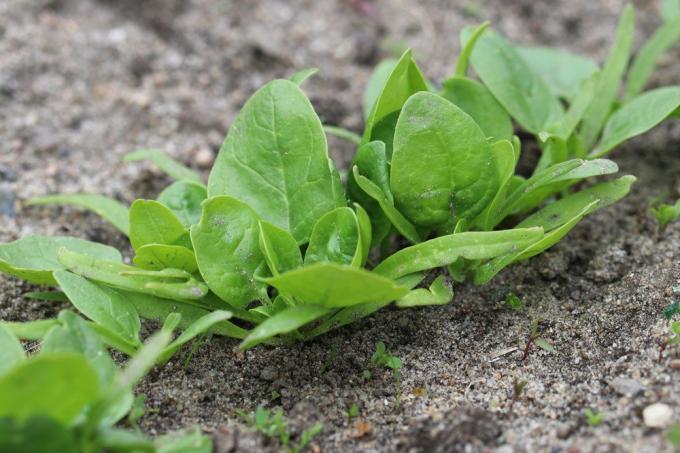
table of contents
- Types of spinach
- Location
- floor
- Sowing time
- sowing
- to water
- Fertilize
- Cut
- wintering
- harvest
Spinach is one of the healthiest and most popular vegetables that you can easily grow yourself in gardens and on the balcony. All you need is professional instructions that explain how to proceed and what to watch out for. You can find them here at the plant expert.
In order for spinach to thrive in your own vegetable patch, you should pay attention to a few important details. These start with the choice of the type of spinach, include a number of factors in sowing and care, and end with the correct approach to harvesting. The plant expert provides information on what is important when growing spinach and what you should pay attention to.
Types of spinach
There are around 50 different types of culture. These differ in terms of growth, harvest time, robustness, time of cultivation and taste. The most common types of spinach that can be grown as early as spring include the following.

Baby-Leaf F1
- upright, tender, deep green leaves
- easy to harvest
- is particularly suitable for salads
butterfly
- most common variety
- very spicy
- high crop yield
- can also be grown in autumn
Emilia F1
- thick-fleshed leaves
- full of flavor
- Harvest time between spring and summer
gamma
- dark green leaves
- late flowering
- can also be grown in autumn
Lazio F1
- newer variety
- Cultivation from spring to late summer
- robust against powdery mildew
Matador
- well-tried way
- frost-proof
- rapid growth
- Cultivation time between spring and autumn
- strong taste
Merlin F1
- tasty aroma
- Summer cultivation possible
- somewhat more susceptible to powdery mildew infestation
Monnopa
- similar to "Gamma", but hardy
Napoli F1
- delicate in taste
- fast growing
- promises high yields
- can be overwintered
Palco F1
- fast growing, high yields
- resistant to powdery mildew
- can be grown again in autumn

Varieties that can be grown from summer at the earliest:
Celesta F1
- promises high yields
- Powdery mildew resistance
Corvette F1
- mid-late hybrid variety
- bulletproof
- very frost-resistant
- full-bodied spinach taste
Types of spinach that are ideal as baby spinach for planting on balconies or boxes:
Bordeaux F1
- best growing season in summer
- Powdery mildew resistance
- small growth
- broad flavor
- ideal for salads
Picasso F1
- best growing season in summer
- small growth
- savoy-like leaves
- year-round harvest
Location
In terms of location, you can choose a place in full sun or partial shade for sowing the leafy vegetables. Strong winds should not be able to hit him.
It gets along very well with many other types of vegetables and can find its place as a pre- and / or post-crop as well as alone or between other types of vegetables. Only a location where there are currently or previously goosefoot plants such as chard, sorrel or beetroot should be avoided. An intolerance arises here. In this case you should always wait three years before sowing spinach in the same place from previous goosefoot plants.
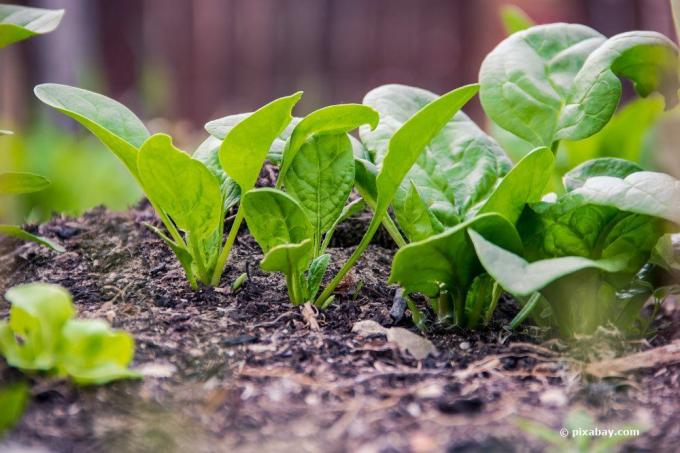
Pre- and post-culture
The advantages of pre- and post-cropping are that most types of spinach are of short daytime and fall in spring and autumn longer night times benefit and as a deep-rooting and preculture the soil is good for many subsequent vegetable plants loosen up. In addition, normal types of spinach usually “shoot” on hot summer days, making them bitter in taste.
As a preculture, spinach is particularly suitable for the following vegetables:
- Carrots
- garlic
- Kohlrabi (later varieties)
Optimal locations for post-cropping from August are harvested beds, for example from:
- New potatoes
- Strawberries
- peas
- Onions
Neighboring beds that can be perfectly complemented with spinach include:
- Beansticks
- tomatoes
- Cucumber
- Cabbage
- radish
floor
For sowing, you should provide the Spinacia with soil that meets the following specific criteria.
- pH between 6.5 and 7.5
- rich in humus (add generous compost to the seeds)
- loose soil so that deep roots can take place
- high humidity (no waterlogging)
- low to medium nutrient content
Sowing time
Most types of spinach are best sown in spring and / or autumn, or at the end of August if the harvest is to take place in the same year. For sowing later than May, only varieties that do not “shoot up” so quickly when the daylight is longer in the summer months are suitable. Examples of these types of spinach include the following.
- Emilia F1
- Lazio F1
- Merlin F1
spring
In spring, the optimal sowing time is March and can take place until the beginning of May.
autumn
The best time for an autumn harvest is the third and fourth week of August. The harvest can then be expected in the course of November. Sowing in early September is only recommended in regions with milder temperatures if you want to harvest in the same year. Until the beginning of October only hardy spinach species should be sown. These specimens are usually ready for harvest at the beginning of April.
Sowing is no longer advisable after the beginning of October. Germination usually still takes place, but in the cold winter the new roots cannot establish themselves sufficiently in the soil and the risk of frostbite is therefore immensely high.
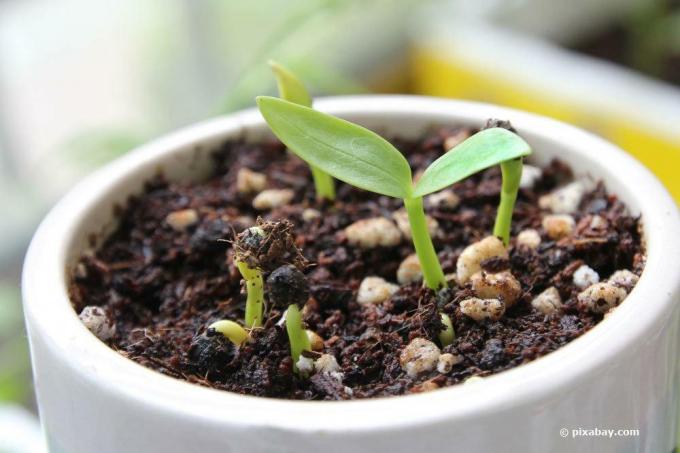
sowing
Seed spacing
If you are sowing spinach in rows, a distance of around 20 centimeters between the individual rows is sufficient. If you place the spinach between other types of vegetables, the dimensioning of the space depends on how wide the neighboring plants are and how big the seeded spinach variety will be. In order to be able to fully develop in its size, the spinach only needs about five centimeters to the right and left of its neighbors.
Soil preparation
So that the seed sprouts well and the roots that develop from it can establish themselves in the earth, you should within a radius of eight to ten centimeters and up to five or eight centimeters deep, the earth is good loosen up. In the same work process, it is advisable to enrich the soil with compost so that sufficient nutrients can be given to the young plant for it to thrive.
If you plant spinach in the same place again in autumn and / or in the following two or three years, the compost does not have to be enriched again. The nutrient content in the soil is sufficient for at least three years. The same applies, of course, to hardy, perennial types of spinach that do not have to be supplied with compost every year. It is also important that the soil is well moistened in which the seeds are to be sown. But avoid waterlogging. Under certain circumstances, this would cause the seed to go moldy and germination would not take place.
sowing
- At a suitable location, use your thumb to press a two to three centimeter deep depression into the earth
- When sowing rows in rows, make a long hollow
- Put in the seeds (keep the distances if the hollow lines are continuous)
- Cover seeds up to the surface of the earth with soil (dark germs)
- Gently tap or press the soil over the seed (optimizes the soil contact of the seed)
- Pour or spray the surface lightly
- at cold temperatures below zero degrees Celsius, stretch a transparent film over the seed
- Do not remove the film until frost is no longer expected
Note: Did you know that you don't have to sow existing seeds right away? As a rule, it can be kept for three or four years, provided it is stored in a dry place. It is in no way inferior to a “fresh” seed in terms of development.
to water
After sowing in the moist soil, it should be kept evenly moist. If a foil is stretched, take it up for a few minutes and then pour. Lifting the film also ensures an exchange of air and promotes growth. You should just make sure that you always use water at the optimal temperature. At warmer temperatures it should be room temperature, while at cold temperatures it can be a little colder, so that no immense temperature difference triggers a temperature shock. This could affect the growth of the spinach.
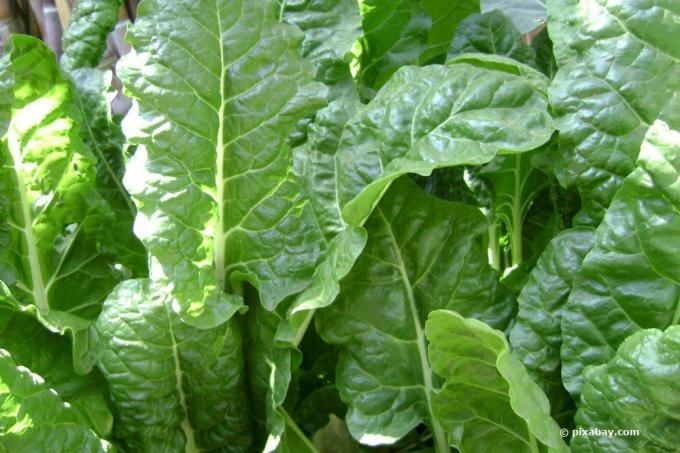
Let the soil dry out, you run the risk that the Spinacia will begin to flower too quickly and is therefore no longer suitable for consumption / harvest. If this happens anyway, pour more immediately so that at least the next generation can grow again.
Fertilize
When it comes to fertilizers and nutrients, the Spinacia is very undemanding. It does not have to be further fertilized during the year and the following three years if it was planted in nutrient-rich soil when sowing.
There is an exception when so-called high-eaters stood in the same place before sowing again. Then it may be that the soil offers only a few nutrients and a compost enrichment could be necessary. Basically, you should be more cautious about giving nutrients, because too much of it can increase the nitrate content in the spinach leaves.
However, for a better yield you can add a little potassium fertilizer at the beginning of growth in spring or late summer / fall. This stimulates growth and has no influence on the nitrate / nitrite content.
Artificial fertilizer
Under no circumstances use artificial fertilizer products. Often the dosage descriptions are not optimal and over-fertilization happened quickly. Here too, harmful nitrate or nitrite and oxalic acid levels rise.
High levels of nitrate / nitrite are considered carcinogenic, while oxalic acid can negatively affect the body's calcium metabolism. As a result, kidney and bladder stones are not uncommon. So stay away from artificial fertilizers if you don't know exactly how much your Spinacia needs.
Cut
This foxtail plant is usually only cut for harvest reasons. However, if the leaves have become brown due to, for example, excessive drying of the earth, a section of these parts of the plant should create space for new, healthy growth will.
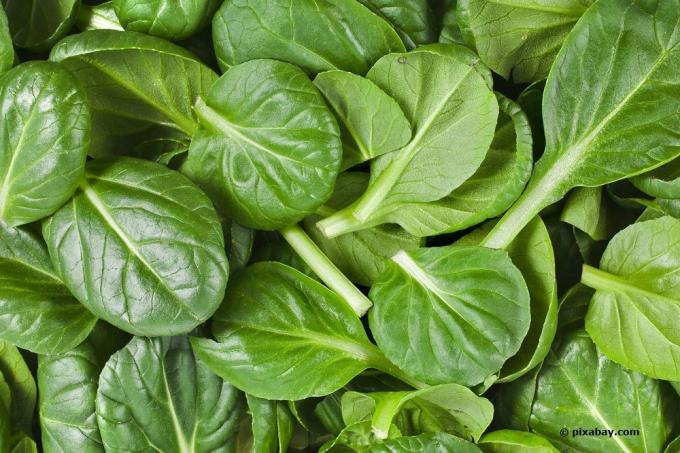
It is also advisable to cut the leaves if there is significant damage from parasites or if a disease requires pruning. It is important that you always leave the so-called spinach heart where it is. Only from this can new leaves develop.
wintering
Most of the time, spinach is only grown for one year. This is especially the case when it is used as a preculture. Nevertheless, many types of spinach are usually well tolerated by frost, some are even completely hardy and can even hibernate outside in the vegetable patch or on the balcony in icy temperatures.
Frost-tolerant specimens should be covered with a fleece at extremely cold temperatures. Frost-sensitive varieties can also be cultivated for two or sometimes three years by using them in one Move to warmer winter quarters, for example to an unheated greenhouse or a light one Garden shed. It is important that the temperatures here are a few degrees above zero and that the room has bright daylight. Hardy spinach that is sown later outdoors should also be covered with a fleece or foil before the first frost and snow. The young plants are still a bit vulnerable and could get signs of frostbite.
harvest
You can usually expect a harvest all year round, provided that you move the spinach into winter quarters or it is a frost-resistant Spinacia. After sowing, it usually takes an average of eleven weeks before the first ripe spinach leaves can be cut.
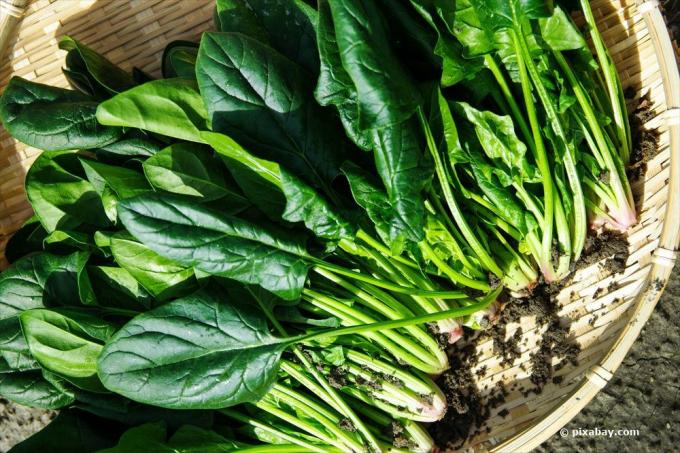
Harvesting outdoors should only take place on frost-free and dry winter days. Otherwise the fresh interfaces could cause frostbite. It should not be harvested when it is in bloom. The nitrate content is highest here and a bitter taste makes it inedible.
Crop cut
For the harvest and renewed, vigorous regrowth of new leaves, you should always separate the spinach leaves individually and always around the heart. In this region new leaves form first and the more often you cut there, the more luxuriant the vegetable plant will grow as a whole. The cut is always applied close to the ground.
Cutting tool
Only use sharp cutting tools that have been disinfected beforehand. Especially with vegetables that are eaten cold, such as in salads, it is important that no viruses and germs get onto the leaves via the cutting tool. Apart from that, transmitting bacteria and viruses damage the plant and can quickly spread to neighboring plants. In the worst case, such an infestation destroys an entire seasonal population. The simplest disinfection method is with a household disinfectant such as Sagrotan.
